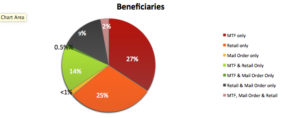Market Report, Uncategorized
Department of Defense Drug Cost-Savings Programs
Department of Defense Drug Cost-Savings Programs. The Department of Defense pharmacy program is on to track to slice $1.3 billion off projected drug costs from 2014 to 2019, thanks to higher beneficiary co-pays, tighter point-of-service rules and recent streamlining of prescription drug processes across the military, explained Dr. George E. Jones, chief of pharmacy operations for the Defense Health Agency (DHA).
One of the more surprising aspects of savings being captured, said Jones, is that average annual out-of-pocket costs for beneficiaries have stayed flat or even fallen, despite recent increases in drug co-payments. As shown in the chart above, 7.8 million beneficiaries filled one or more prescriptions in fiscal year 2015.
As mandated by the 2015 National Defense Authorization Act, beneficiaries who take brand-name maintenance medications must fill their prescriptions at military treatment facilities or through TRICARE’s mail-order pharmacy. Generics and medications for acute illnesses can still be filled through retail pharmacies.
That’s because changes to law and policy have forced or enticed beneficiaries to use more efficient points of service than retail outlets. Those who need maintenance drugs for chronic conditions must now use mail order where refills are for three months for the same or smaller co-pay than charged for a month of pills at retail. Also base pharmacies, where drugs are still dispensed free of charge, have expanded their formularies, or drugs they must stock, to better support nearby beneficiaries.
Cost savings efforts in drug dispensing on a total of $11.6 billion in fiscal year 2015.
The big move was requiring beneficiaries who want brand name maintenance drugs to get them via home delivery or on base, ending their availability at retail pharmacies unless beneficiaries pay the full cost.
Of 9.4 million beneficiaries eligible to the use the pharmacy benefit, 82 percent did so in fiscal 2016. That was up from 66 percent in 2002, before the TRICARE mail order program began. A total of 7.7 million beneficiaries got at least one prescription filled in 2015 and 2016, two million more than in 2002. Prescriptions filled across all three points of service totaled 127 million in 2016 versus 82 million in 2002, a 55 percent jump.
Almost 60 percent of beneficiaries are retirees or their family members: 3.1 million (33.2 percent) are retirees 65 and older and their dependents; 2.2 million (23.7 percent) are younger retirees and their family members. About 1.5 million beneficiaries (16.4 percent) are active duty and two million (21.4 percent) are family members of active duty.
Additional information on Government Healthcare with a focus on the DoD and VA with an emphasis on pharmacy is available in AMI’s Government Healthcare 2016 Overview.



